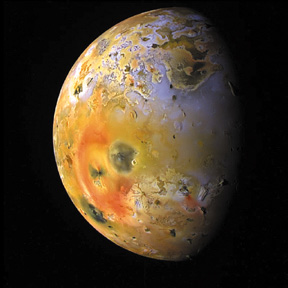geotimesheader
News
Notes
Planetary
Geology
Spouting
off about Io
| More than 100 volcanoes vent sulfurous material
onto the surface of Jupiter’s moon Io. Recent observations have shed light
on several of the volcanic phenomena, some of which have remained enigmatic
since Voyager first visited the jovian system more than 20 years
ago.
The largest volcanic plume observed by Voyager
rose 300 kilometers above the volcano Pele. Following observations made
by the Galileo spacecraft and the Hubble Space Telescope in the mid- to
late-1990s, scientists believed the plume contained sulfur dioxide gas.
In the May 19 issue of Science, a team of researchers led by John
R. Spencer of the Lowell Observatory in Flagstaff, Ariz., reported that
they also observed gas containing a rare compound of sulfur (S2)
emanating from Pele.
Using images from Hubble, they isolated the spectral
absorption of the sulfur gas against the background of Jupiter’s spectra.
The Hubble discovery is only the third astronomical observation of the
UV-radiation-sensitive S2, the others being from comets and
the impact sites of Shoemaker-Levy 9 on Jupiter.
|

In this enhanced color composite of Io, deposits of sulfur dioxide
frost appear as white and gray hues. Other sulfurous materials
appear as yellow and brownish hues. Bright red materials, such as
the prominent ring surrounding Pele, and "black" spots with low
brightness mark areas of volcanic activity. NASA/JPL. |
The researchers also suggested that the sulfur
may polymerize into reddish compounds that could give Io its distinctive
coloration. Modeling currently underway by Julie Moses of the Lunar and
Planetary Science Institute in Houston may help determine whether condensing
S2 gas is the culprit behind the colored surface.
In the same issue of Science, a team of
researchers led by Susan W. Kieffer of S.W. Kieffer Science Consulting
Inc. in Ontario, Canada, presented a model to explain the wandering of
the gaseous plume emanating from Io’s volcano Prometheus. The plume has
wandered 85–95 kilometers from the point of its discovery by Voyager
in 1979, to the location recently observed by the Galileo probe. “The observation
team and I realized that we had a major challenge in explaining this wandering,”
Kieffer says, “because we have never seen it on Earth.” According
to Kieffer, the goal was to devise a testable hypothesis for how the plume
could remain active for 20 years and still maintain its constant shape
and optical properties. The researchers show that the critical property
is the plume’s mass flux, which must remain unchanged for the 20-year period.
The researchers propose that the wandering can
be explained by the vaporization of a “snowfield” of sulfur compounds over
which a lava flow is moving. The melted, sulfurous fluid at the base of
the lava erupts to the surface much like a rootless conduit on Earth (an
eruption conduit that is not attached to a magma chamber).
In the May 4 issue of Nature, Amara L.
Graps and a team of researchers led by Eberhard Gruen of the Max-Planck-Institut
für Kernphysik in Germany pinpointed Io’s volcanoes as the source
for a far-reaching dust stream that emanates from the jovian system. Using
data from Galileo’s Dust Detector System, the researchers were able to
observe both the frequency of dust emission and the general sizes of the
particles.
The team determined the strong likelihood of an
Io volcanism source and eliminated other potential sources, such as Jupiter’s
gossamer ring and Io’s impact ejecta. While the dust composition is most
likely sulfurous, “it’s a difficult measurement,” Graps says. “People doing
chemical analysis and interpretation of dust particles . . . are sometimes
surprised with what their spectra look like. This is a new field.”
The analyses of the Io dust stream will hopefully
come in December. That is when the Cassini space probe will join
Galileo to observe Io, and the combination of its onboard Cosmic Dust Analyzer
and Galileo’s Dust Detector System may allow researchers to determine an
accurate composition.
Josh Chamot
Geotimes contributing
writer

